The Economics and Statistics Division maintains archives of previous publications for accountability purposes, but makes no updates to keep these documents current with the latest data revisions from Statistics Canada. As a result, information in older documents may not be accurate. Please exercise caution when referring to older documents. For the latest information and historical data, please contact the individual listed to the right.
<--- Return to Archive
For additional information relating to this article, please contact:
November 06, 2023CANADIAN COMMUNITY HEALTH SURVEY, 2022 Statistics Canada has released results from the 2022 Canadian Community Health Survey (CCHS). This survey is an annual population health survey that provides insight into life satisfaction, stress, perceived health, health conditions and behaviours of the Canadian population. The CCHS survey excludes persons living on reserves and other Aboriginal settlements in the provinces; full-time members of the Canadian Forces; the institutionalized population, children aged 12-17 that are living in foster care, and persons living in the Quebec health regions of Région du Nunavik and Région des Terres-Cries-de-la-Baie-James.
Life satisfaction
In Nova Scotia, 85.3% of the population reported being satisfied or very satisfied with their lives at the moment (reporting a score of 6 or greater on a scale of 1 to 10). Nova Scotia was tied with British Columbia for the second lowest life satisfaction across provinces, ahead of Prince Edward Island. Across Canada, 87.2% of the population reported being satisfied or very satisfied with their lives. Life satisfaction scores were highest in Québec.
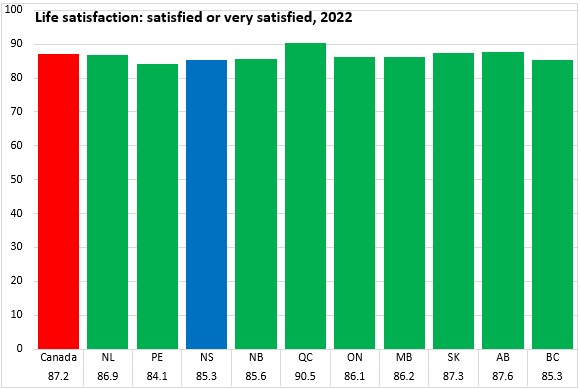
Prior to 2022, over 90% of the population consistently reported being satisfied or very satisfied with their lives. In 2022, life satisfaction dropped markedly at both the national and provincial levels.
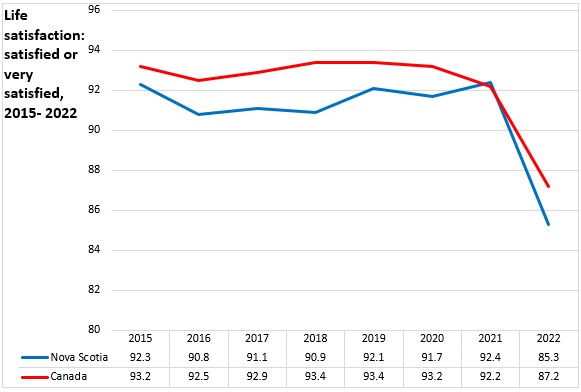
Nova Scotia's life satisfaction was higher for the youngest (ages 12-17) and oldest (ages 65 and older) cohorts. Nova Scotia's lowest life satisfaction results were reported among those aged 18-34, particularly among females. Nationally, life satisfaction was stronger among youth (particularly males).
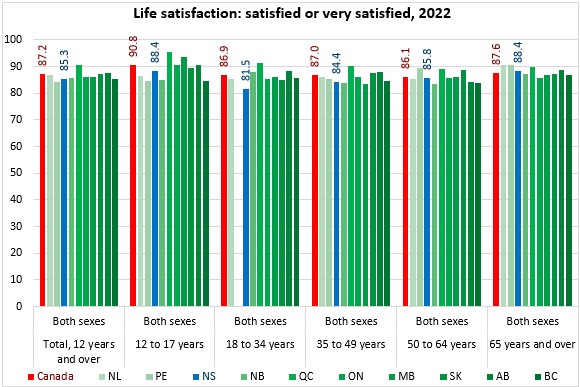
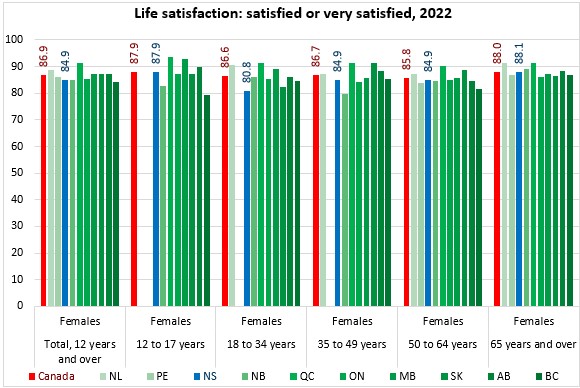
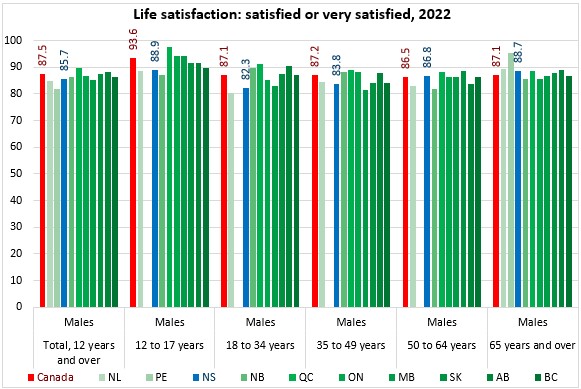 '
'
Life satisfaction by income group in Nova Scotia was lowest for those in the lowest quintiles of earnings. Life satisfaction was higher for those in higher income quintiles. By education, those with a high school education (HS) or less (<HS) reported a lower percentage who are satisfied or very satisfied with their life at the moment than those with post secondary education (PSE). By age and sex cohorts, youth and seniors in Nova Scotia (ages 12-17) reported the highest share who were satisfied or very satisfied with their lives.
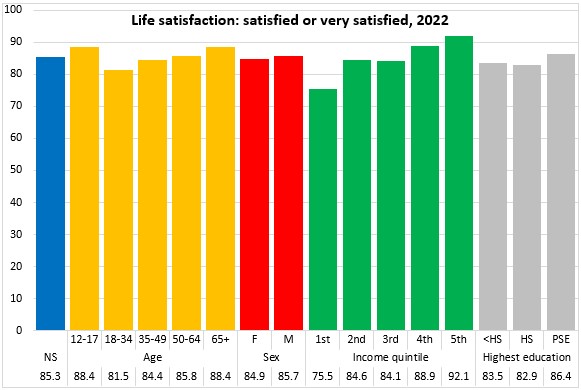
Sense of belonging to community
In Nova Scotia, 69.0% of the population reported feeling a sense of belonging to their local community, which was higher than the national average of 64.5%. The sense of belonging to community is strongest in Newfoundland and Labrador and lowest in Quebec.
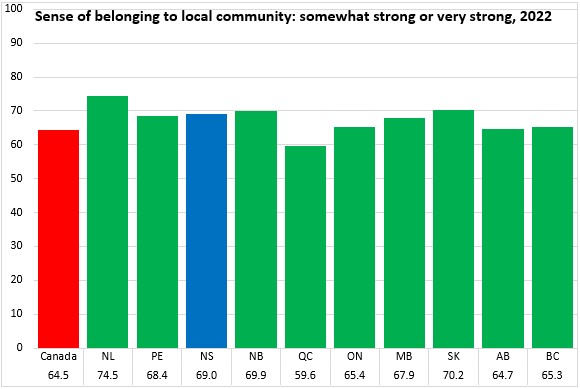
Sense of belonging to community has been declining over the last two years, particularly in 2022.
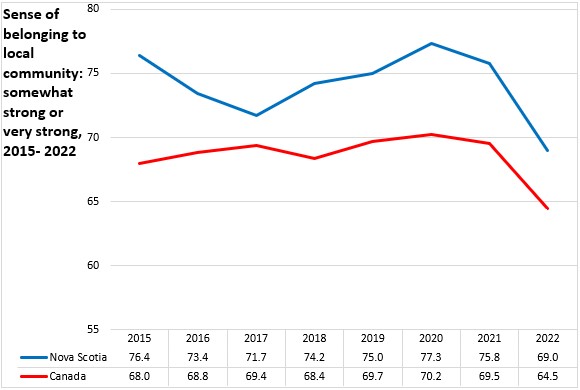
In Nova Scotia, sense of belonging to community was highest among seniors and lowest among those aged 35 to 49. Across Canada, sense of belonging to community was highest among youth and lowest among those aged 18 to 34.
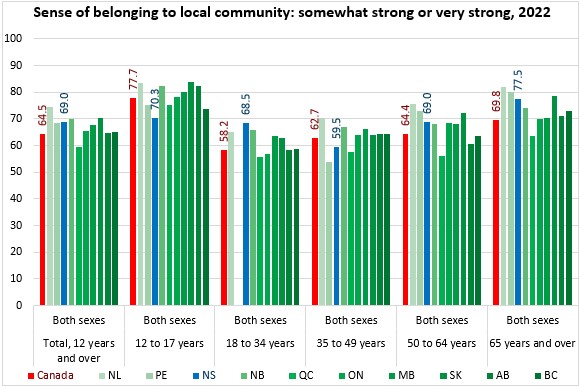
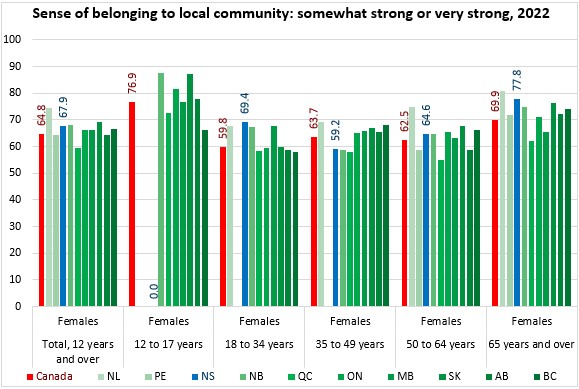
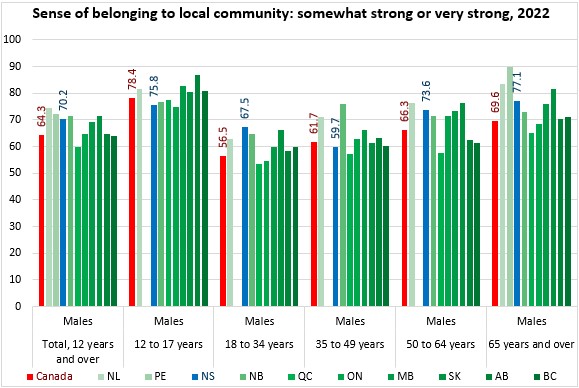
There was a lower sense of belonging to community among Nova Scotians in the lowest income quintile and a higher sense of belonging among those with less than a high school education.
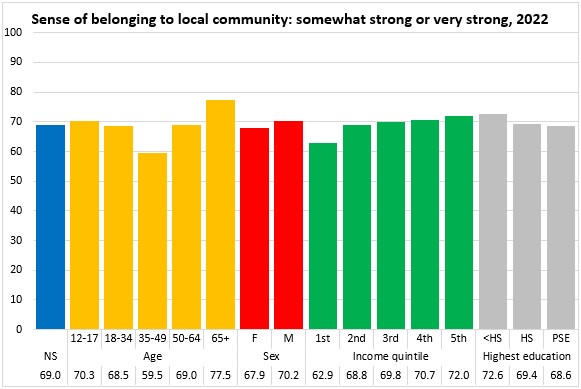
Life stress
Nova Scotians (21.5%) generally reported about the same levels of life stress as the national average (21.8%). Life stress was highest in Prince Edward Island and lowest in Newfoundland and Labrador.

Life stress increased in 2022, both provincially and nationally.
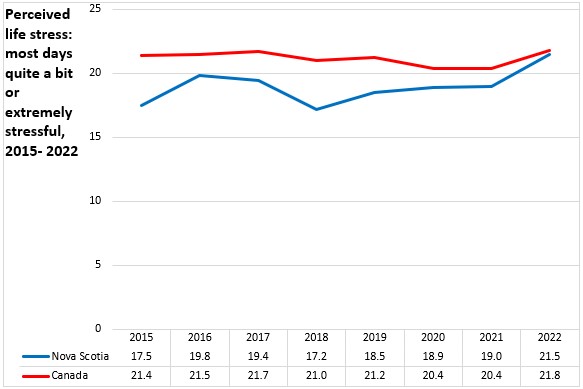
Life stress was felt most acutely by Nova Scotians aged 18 to 34 and 35 to 49 and quite particularly among females in these age cohorts. Youth and seniors reported lower levels of life stress in Nova Scotia.
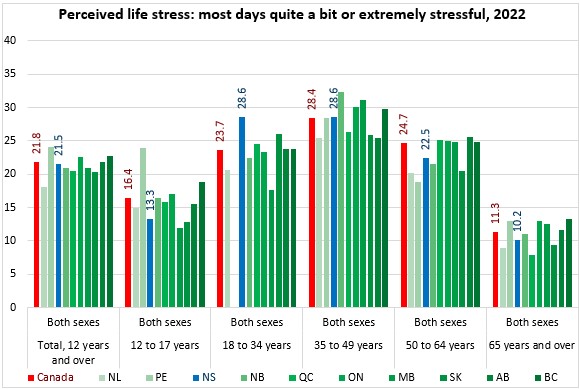
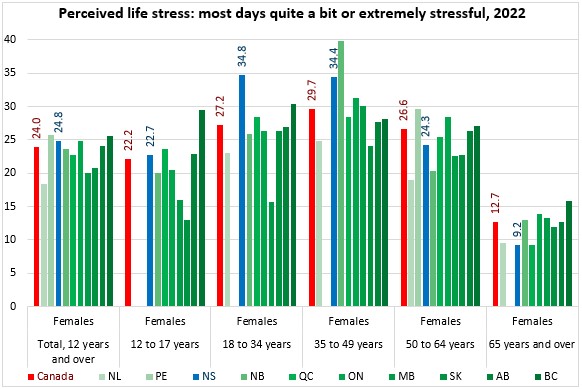
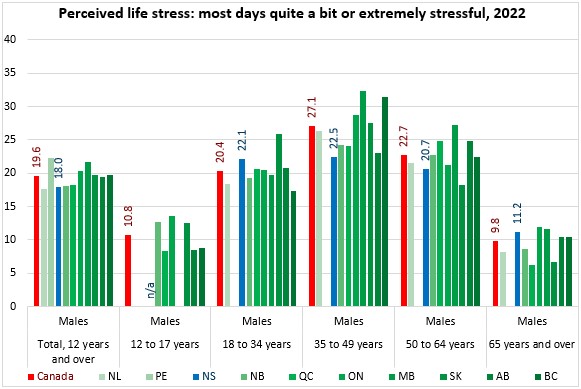
Life stress was quite similar across income ranges, but notably higher for those with post-secondary education and lower for those with less than a high school education.
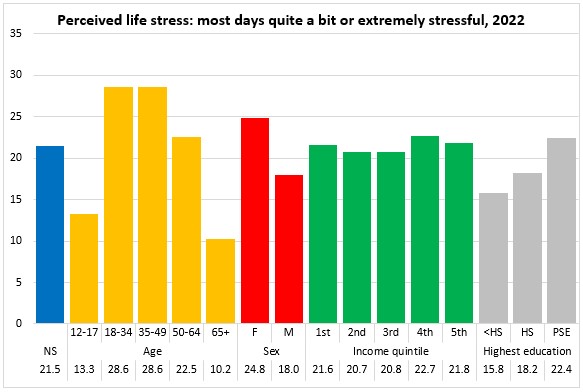
Perceptions of physical and mental health
The CCHS asks Canadians how they perceive their physical and mental health.
Among Nova Scotians aged 12 and up, 52.8% reported very good or excellent physical health, below the national average of 55.3%. New Brunswick and British Columbia had the lowest shares reporting excellent or very good physical health while those in Quebec reported the highest share. 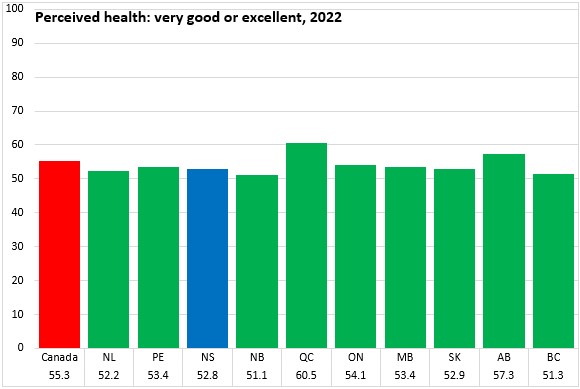
Perceptions of very good or excellent health have declined considerably in the last two years at both provincial and national levels.
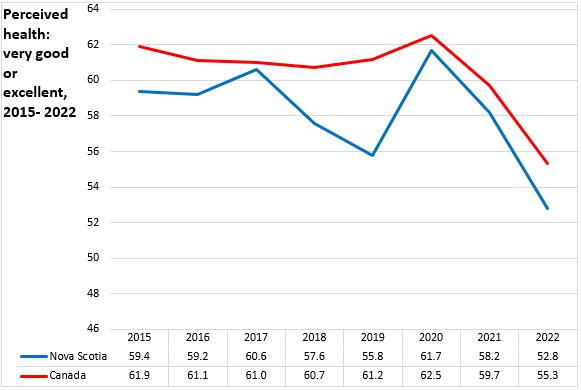
Perceived health is strongest among youth and declines with age. Male youth report the strongest perceptions of very good health, though male seniors report the weakest perceptions of health.
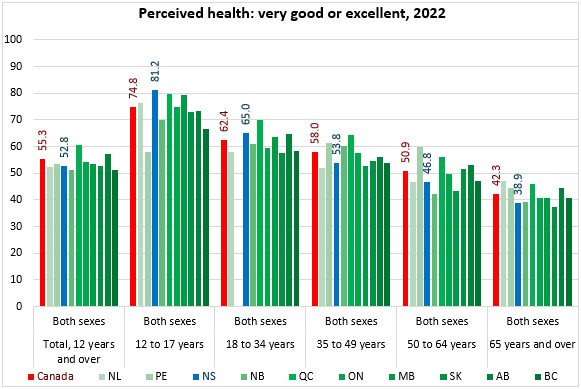
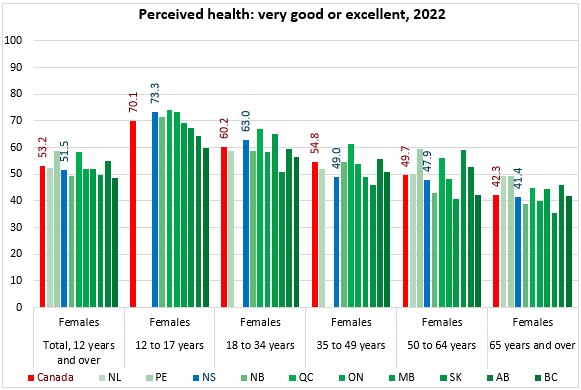
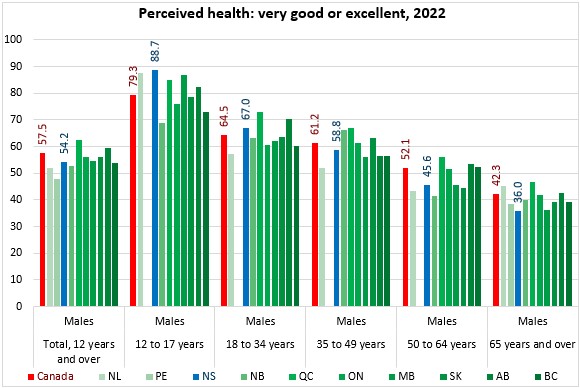
Perceptions of very good or excellent physical health rise with income and education levels. Perceived physical health declines with age. The relatively older populations in the Maritimes contribute to lower perceptions of physical health.
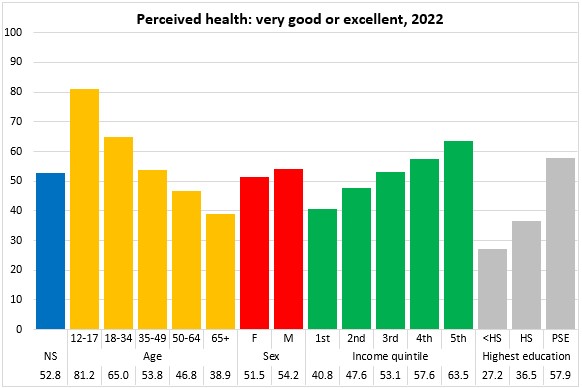
In Nova Scotia, 15.7% perceived fair or poor health in 2022. This was above the national average (13.8%). Perceptions of fair/poor health were most prevalent in Newfoundland and Labrador as well as in New Brunswick. Québec reported the lowest perceptions of fair/poor health.
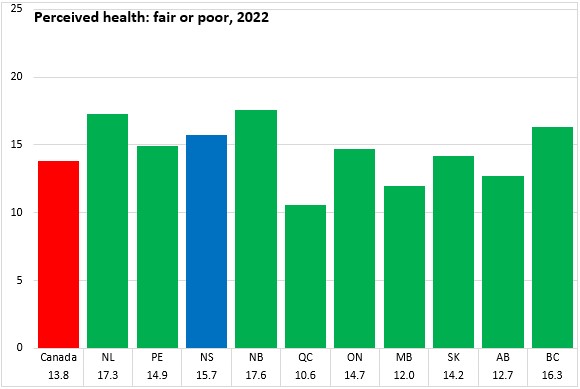
Perceptions of fair/poor health increased in Nova Scotia and Canada in 2022.
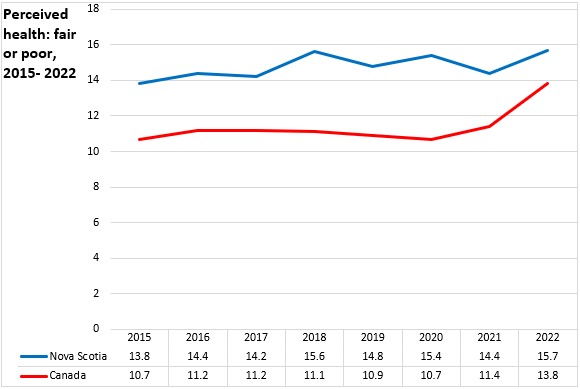
Perceptions of fair/poor health rise with age, particularly among males.
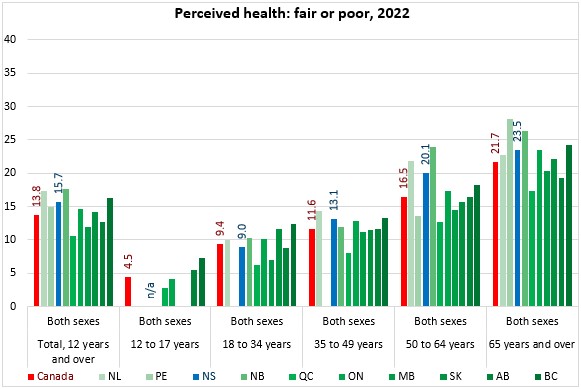
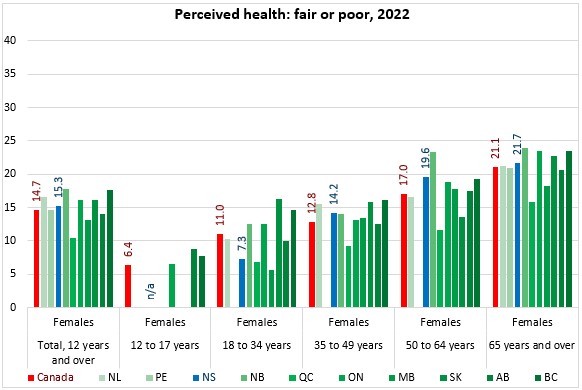
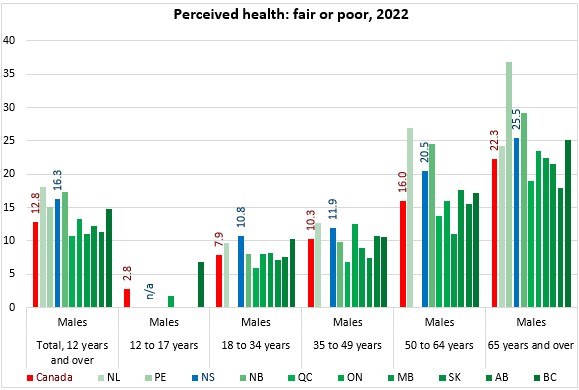
Perceptions of fair/poor health were most widespread among those in lower income quintiles as well as among those with lower levels of education.
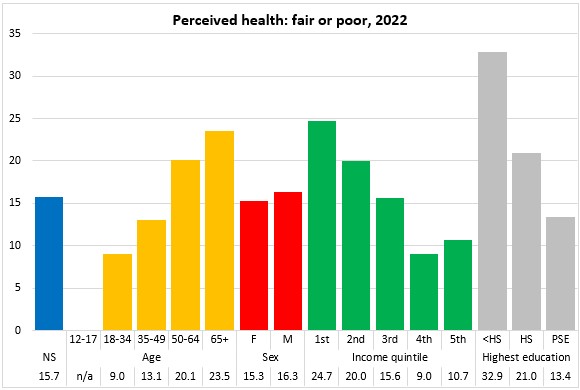
Nova Scotians reported the lowest prevalence (49.4%) of very good or excellent mental health. Nationally, 55.0% of the population reported very good or excellent mental health, with the highest share in Québec.
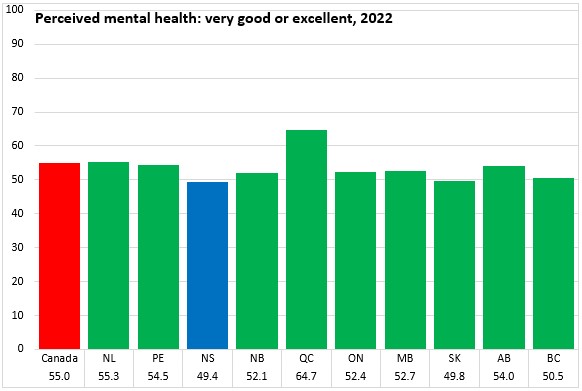
With the exception of a rise in Nova Scotia in 2020, perceptions of very good or excellent mental health have been trending down since 2015. The declines in 2021 and 2022 were steeper.
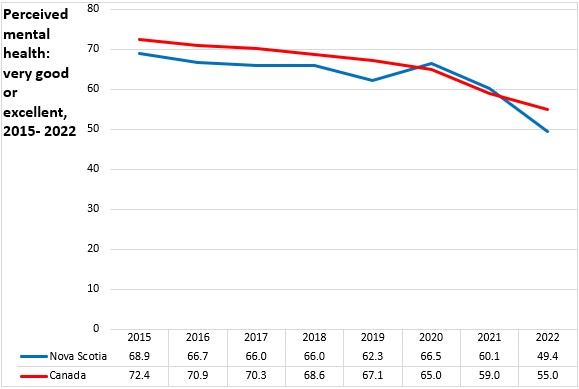
Perceptions of very good or excellent mental health were strongest among youth (especially males) and seniors. Those aged 18 to 34 and 35 to 49 reported the weakest perceptions of very good or excellent mental health (particularly among females).
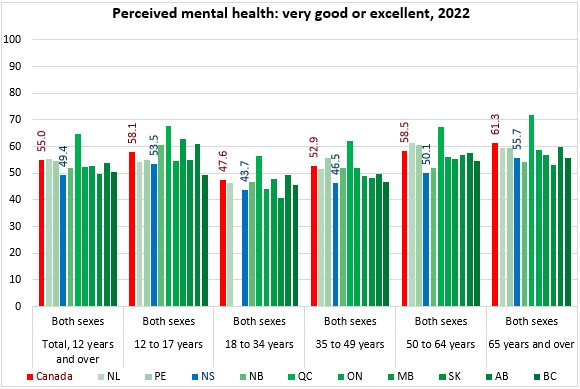
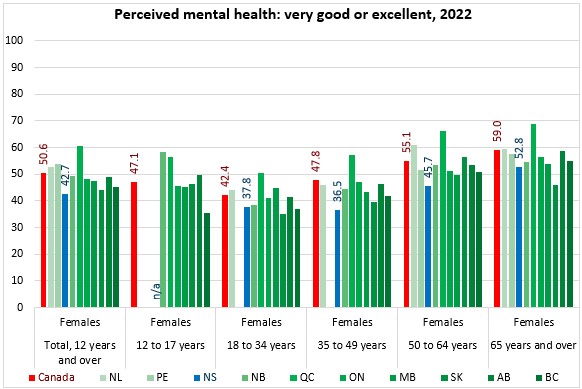
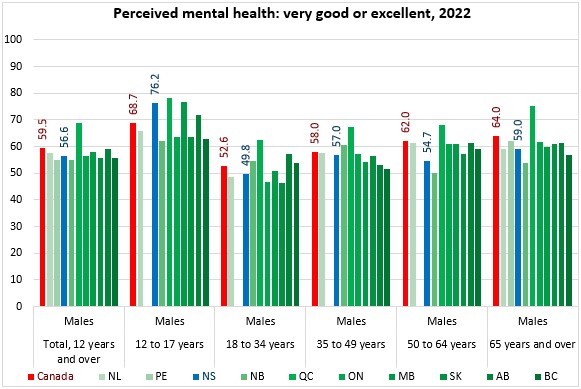
Perceptions of very good or mental health in Nova Scotia rise with income and with education. Males reported stronger perceptions of mental health than females.
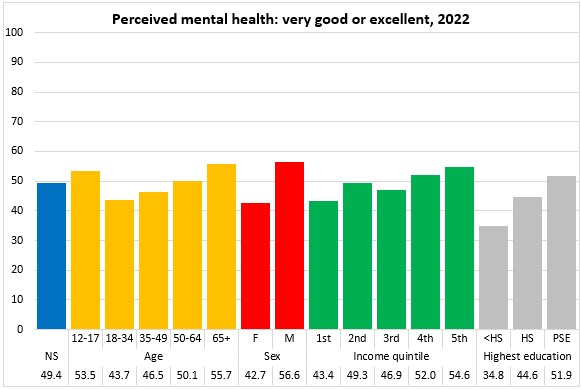
Nova Scotia's portion (16.3%) of the population that reported only fair or poor mental health was above national average (14.4%). Québec has the smallest portion of the population that reports fair or poor mental health.
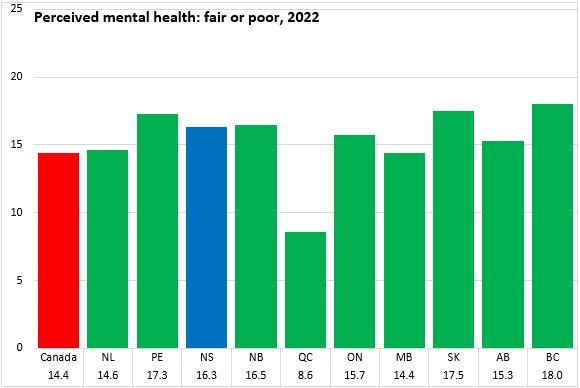
Perceptions of fair or poor mental health have been rising since 2015.
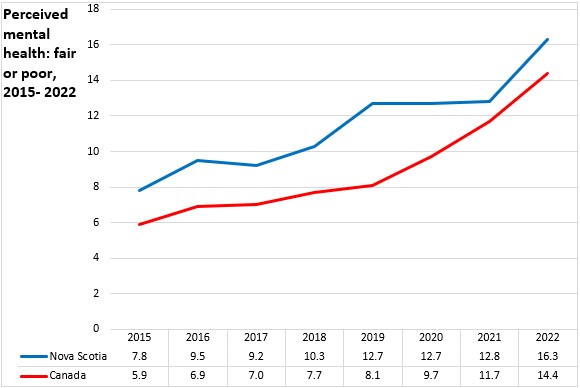
Perceived fair or poor mental health was most prevalent among Nova Scotians aged 18 to 34 (especially among females) and 35 to 49.
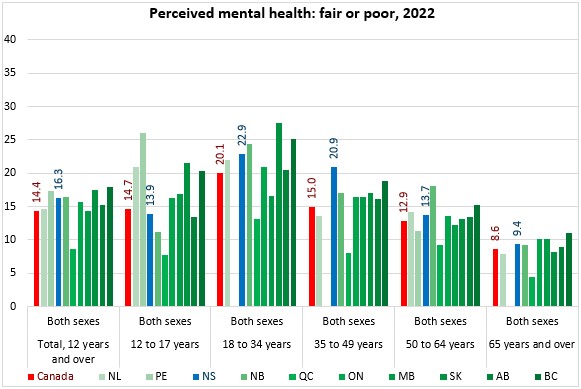
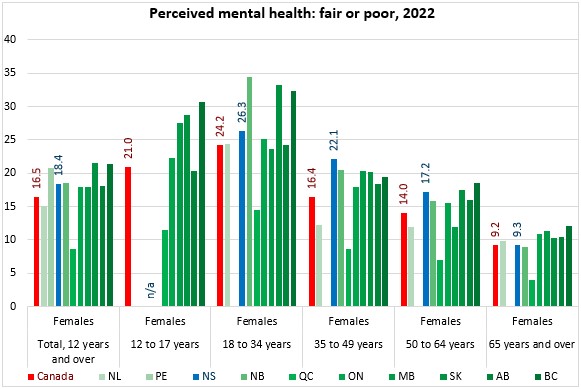
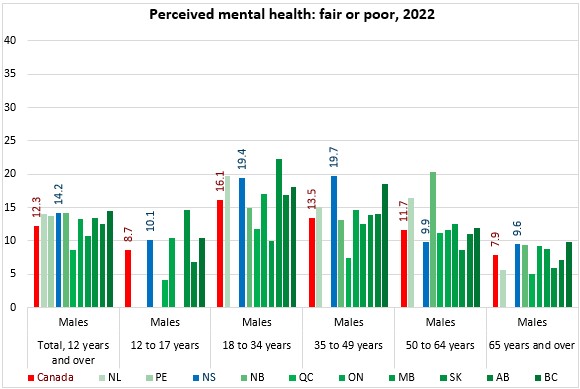
Perceptions of fair or poor mental health were notably more prevalent among those in the lowest income quintile and least prevalent among those in the highest income quintile.
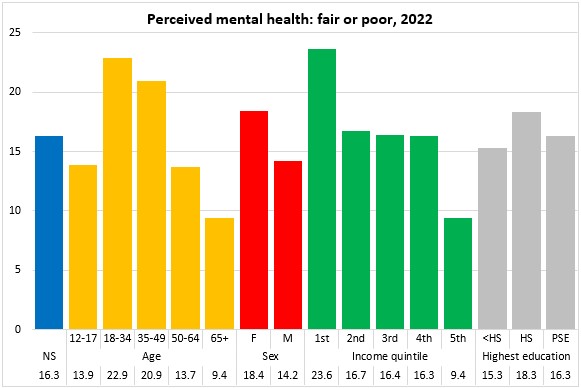
Health conditions
The portion of Nova Scotia's adult population that reports being overweight (34.1% using an adjusted self-assessment) is slightly lower than the national average (34.7%) . However, the portion of Nova Scotian adults who report obesity (35.9%) is considerably higher than the national average (30.0%).
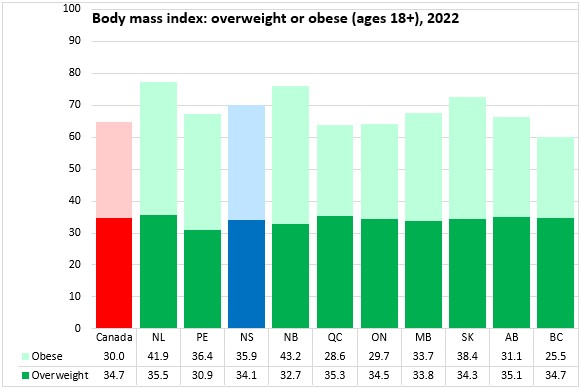
Nova Scotia's reported levels of overweight and obese populations have been fairly stable, as has the share of the Canadian population that report being overweight. The share of Canada's population that reported being obese is lower than the share in Nova Scotia, but it is rising.
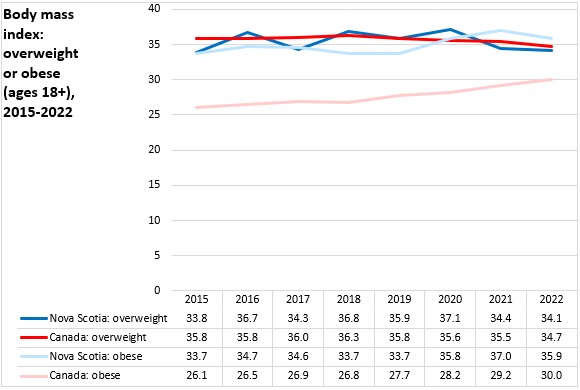
Being overweight or obese is more common among older populations as well as among females. The prevalence of obesity falls with both income and education.
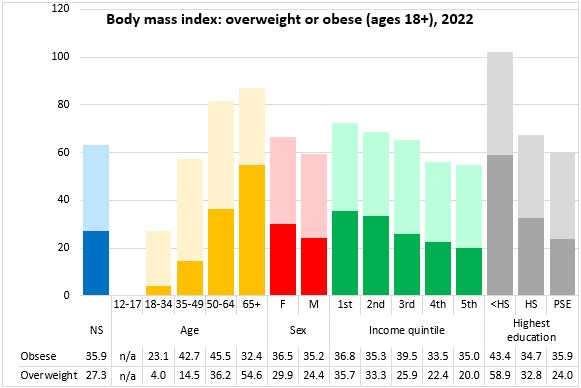
Among common chronic health conditions, Nova Scotia has the highest prevalence of arthritis, tied with Newfoundland and Labrador at 27.3% of the population aged 15 and older.
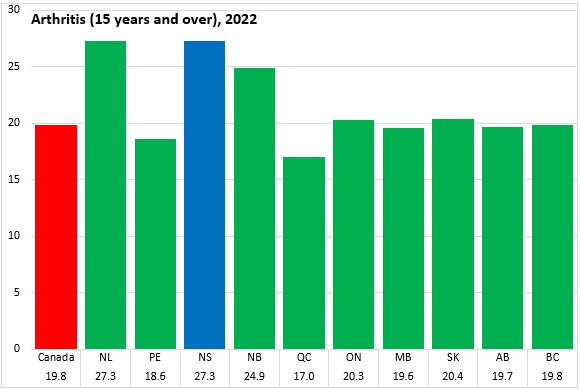
Arthritis is much more common among older age cohorts and among females. The prevalence of arthritis declines with both income and education.
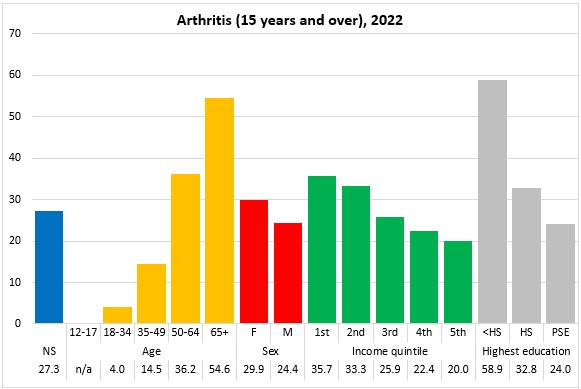
Nova Scotia reported the second highest prevalence (9.8%) of diabetes after Newfoundland and Labrador. The national prevalence of diabetes was 7.8% with the lowest share in British Columbia.
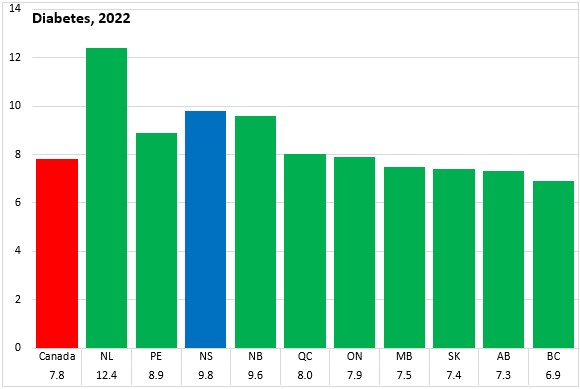
Diabetes is more common among older Nova Scotians and males as well as among those with less than a high school education.
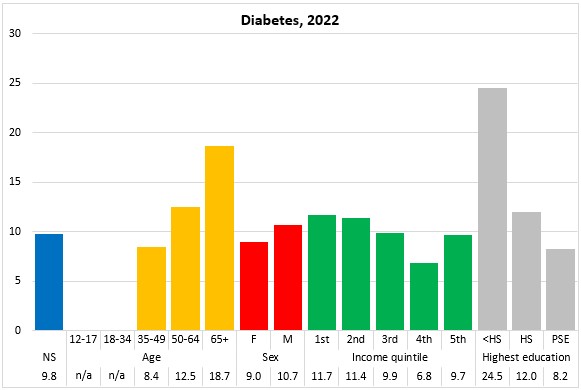
Nova Scotians reported the third highest prevalence of high blood pressure (21.9%), after Newfoundland and Labrador and New Brunswick. Nationally, high blood pressure was reported in 18.8% of the population in 2022, with the lowest share in Alberta.
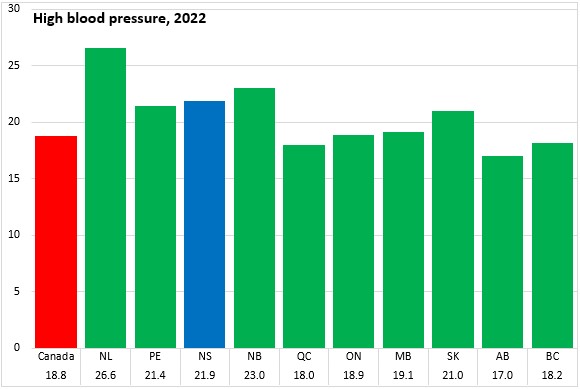
High blood pressure was more commonly reported among older age cohorts as well as among those in lower income and education groups. Males and females reported identical prevalence of high blood pressure in Nova Scotia.
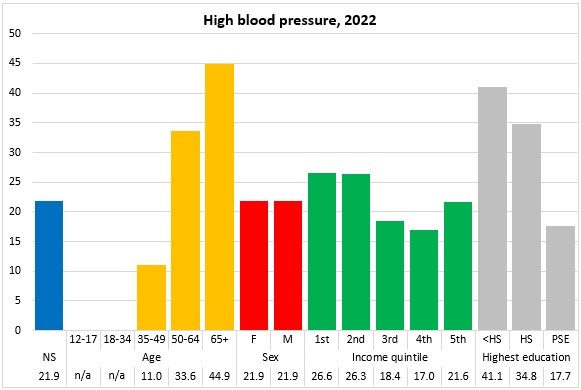
Nova Scotians reported the highest prevalence of mood disorders in 2022: 14.4%. Nationally, 11.4% of the population reported a mood disorder with the lowest share in Québec.
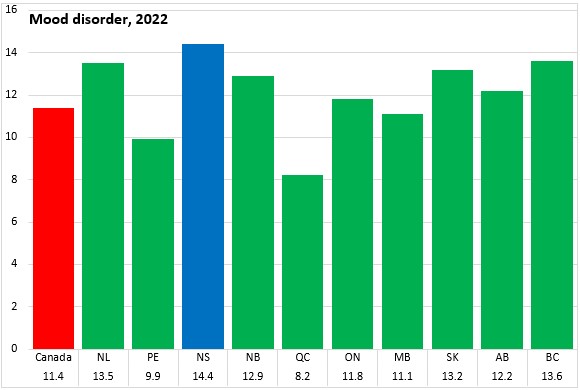
Mood disorders were notably more prevalent among Nova Scotians aged 35-49 as well as among females and those in the lowest income quintile.
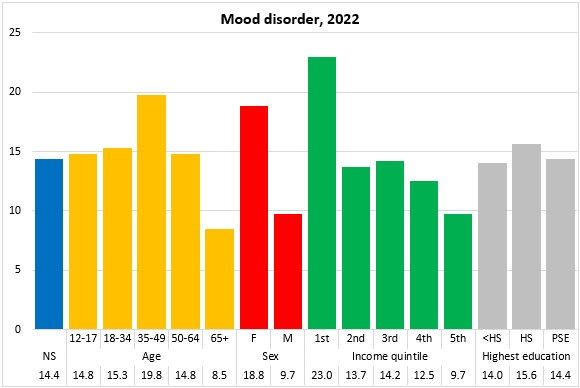
Nova Scotians reported the second highest prevalence of anxiety disorders in 2022 at 17.8% of the population. Nationally, 14.8% of the population reported anxiety disorders with the highest share in Newfoundland and Labrador and the lowest share in Manitoba.
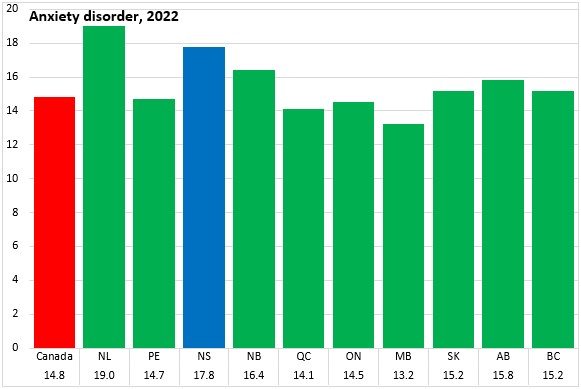
Anxiety disorders were notably more prevalent among females than among males. Anxiety disorders were more prevalent in younger age cohorts as well as among those with lower levels of education and income.
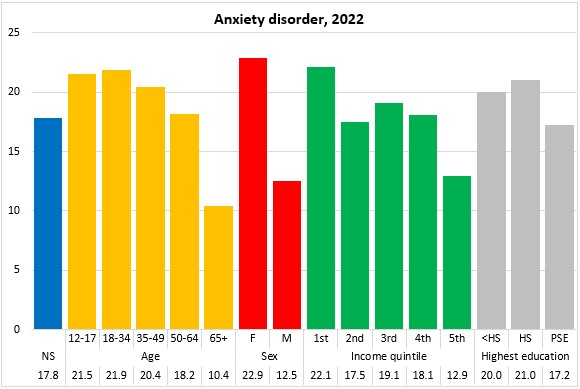
Healthy behaviours
Nova Scotia reported the third highest portion of daily smokers among provinces (12.7%), after Prince Edward Island and Newfoundland and Labrador. Nationally, 9.1% of the population were daily smokers with the lowest smoking rates in British Columbia.
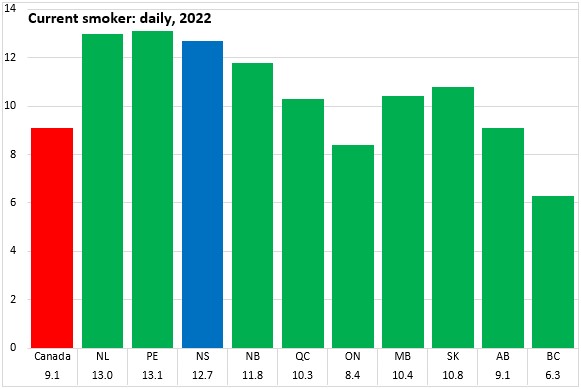
Nova Scotia's smoking rates have been trending down, but there are years (particularly 2022) when smoking rates have risen. Nationally, smoking rates decreased steadily until 2022, when they increased again.
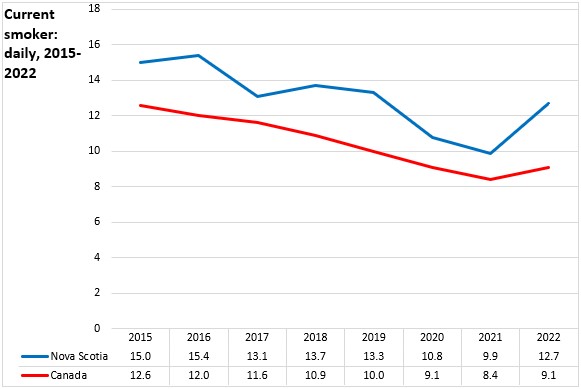
Smoking is more common among Nova Scotians aged 50-64 as well as among those in the lowest income quintile and those with high school or lower education levels. Smoking was slightly more common among females than among males.
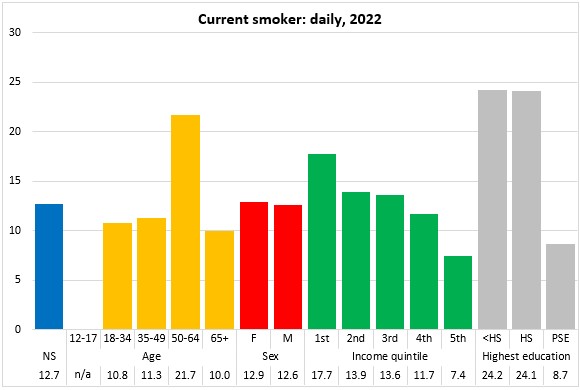
Nova Scotians report the highest prevalence of daily cannabis use (9.1%). Nationally, 6.1% of the population reported daily cannabis use, with the highest shares in Atlantic Canada and the lowest share in Québec.
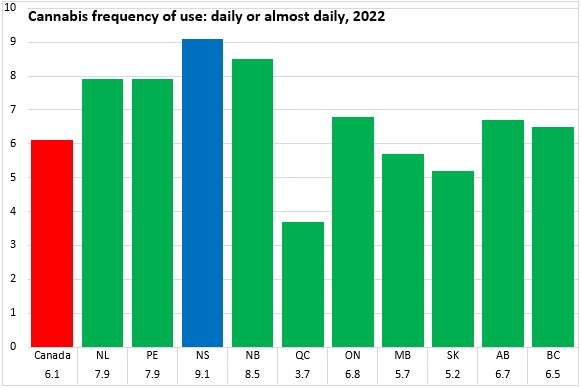
Since legalization, prevalence of daily cannabis use declined in Nova Scotia until 2022. Nationally, daily cannabis use has been rising slowly.
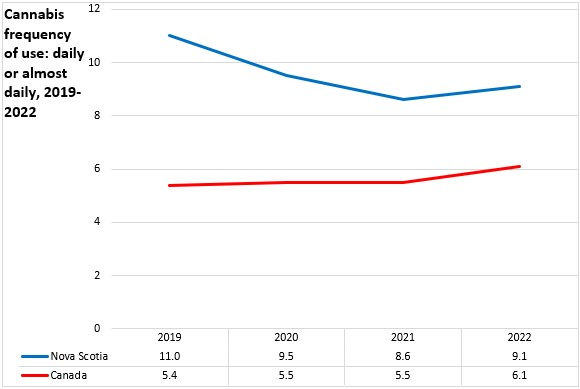
Daily cannabis use was more common among Nova Scotians aged 18-34 as well as among males. Cannabis use was less prevalent among seniors, those in the highest income quintile and those with post secondary education.
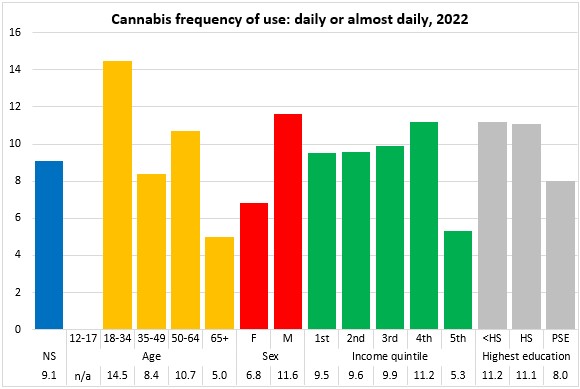
In Nova Scotia, 6.2% of the population reported using an e-cigarette or vaping device within the last 30 days. This was above the national average (5.8%). Vaping was most common in Prince Edward Island and least common in New Brunswick.
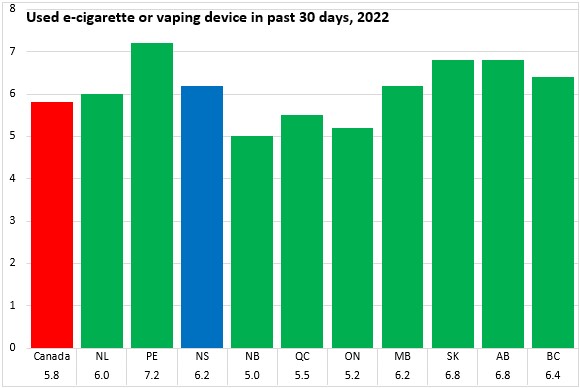
Use of e-cigarettes in Nova Scotia was substantially higher among those aged 18-34 as well as among males and those in the lowest income quintile.
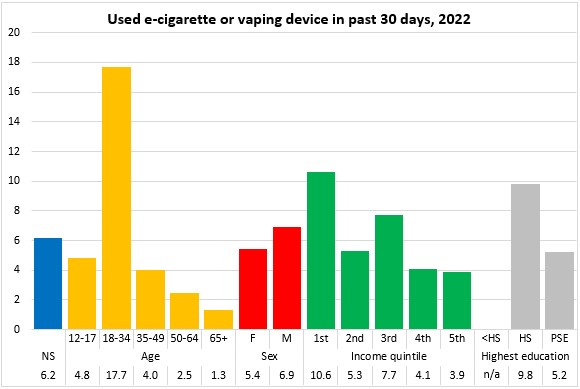
In Nova Scotia, 21.5% reported episodes of heavy drinking, which was above the national average of 19.7%. Newfoundland and Labrador reported the highest frequency of heavy drinking while Ontario reported the lowest.
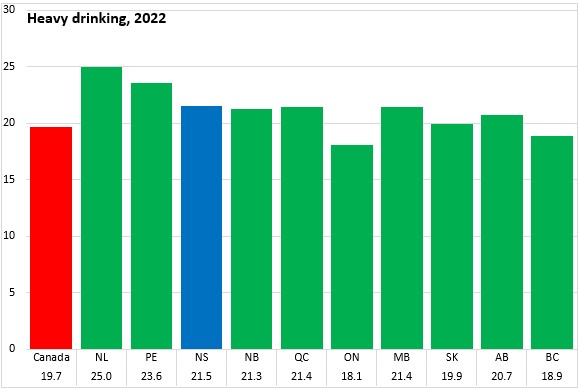
Heavy drinking was up in Nova Scotia and in Canada last year.
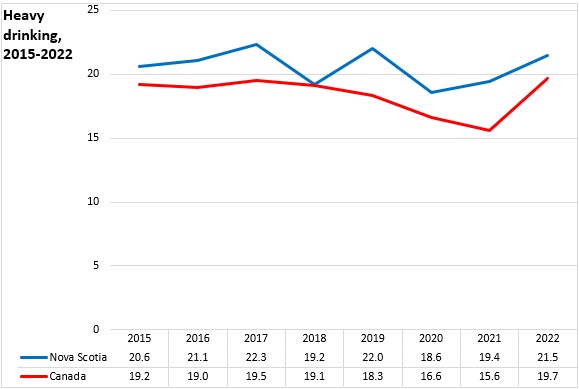
Heavy drinking declines with age in Nova Scotia. but rises with income. Males were more likely to be heavy drinkers than females.
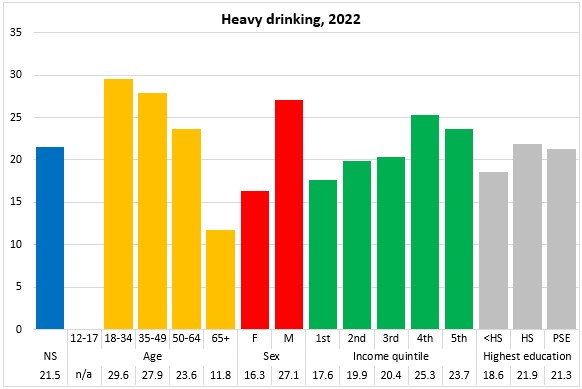
Nova Scotia consistently reports higher use of influenza vaccinations than the national average. In 2022, 46.7% of Nova Scotians reported getting an influenza vaccine in the previous 12 months - the second highest portion after Newfoundland and Labrador. Nationally just over one-third of the population (34.3%) reported getting a flu vaccine, with the highest shares in Atlantic Canada and the lowest shares in Québec.
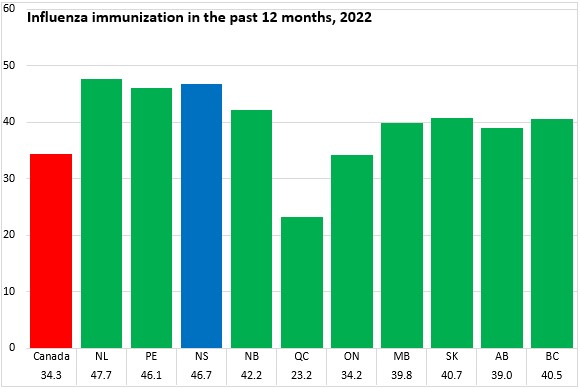
Use of influenza vaccines had been rising prior to the pandemic. In 2022, influenza vaccination was still below pre-pandemic levels.
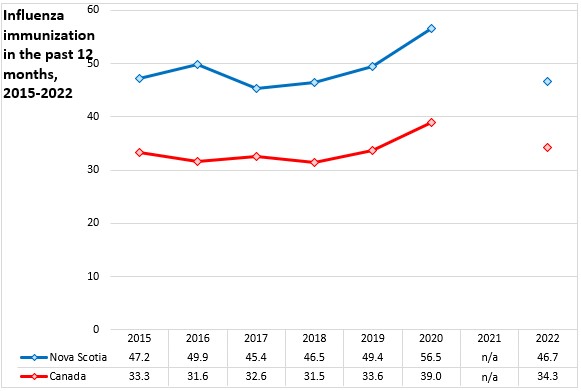
Use of influenza vaccines in Nova Scotia rises with age. Females and those with less than a high school education were more likely to get the flu vaccine in 2022.
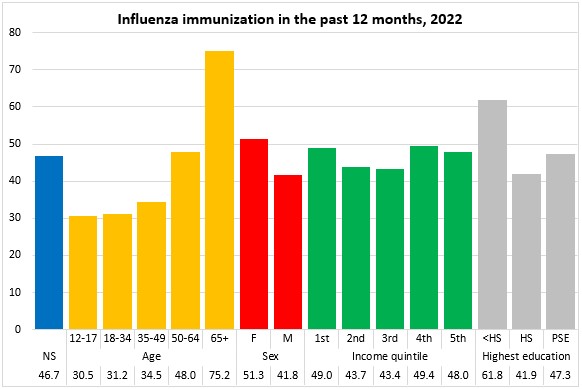
Source: Statistics Canada. Table 13-10-0096-01 Health characteristics, annual estimates; Table 13-10-0097-01 Health characteristics, annual estimates, by household income quintile and highest level of education
<--- Return to Archive